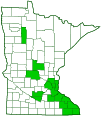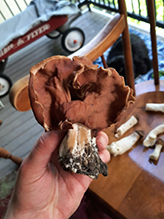Gabled False Morel
(Discina brunnea)
Conservation • Description • Habitat • Ecology • Distribution • Taxonomy
|
|
||||||||||||||
Description |
Gabled False Morel is the most common false morel (Gyromitra species) in Minnesota and Wisconsin. It is found in the spring, alone or in groups, on the ground under hardwood trees. It is saprobic, obtaining nutrients from rotting wood, and might also be mycorrhizal, having a mutually beneficial relationship with the tiny rootlets of trees. It may exhibit both traits at different parts of its life cycle. The cap is 1¼″ to 3½″tall and 2″ to 4″ wide, hollow, and loosely wrinkled. It is usually saddle-shaped or winged, divided into 2 or 3 strongly projecting lobes that are fused to each other. The upper surface is tan to reddish-brown and hairless. The lower surface is pale buff to tan, downy, and exposed in places. The margins are free from the stalk. The stalk is white, hollow, ¾″ to 3½″tall, and ¾″ to 2″in diameter. It is irregular in shape, widened and ribbed near the base. The flesh is brittle, whitish, and chambered. It is edible but due to its similarity in appearance to poisonous false morels, eating is not recommended. |
Similar Species |
Habitat and Hosts |
Under hardwoods |
Ecology |
Season |
Late May to early June |
Distribution |
||
|
Sources |
|
| 5/7/2024 | ||
Occurrence |
||
Common and widely distributed in eastern North America |
||
Taxonomy |
|
Kingdom |
Fungi (Fungi) |
Subkingdom |
Dikarya |
Phylum |
Ascomycota (Sac Fungi) |
Subphylum |
Pezizomycotina (Sac Fungi and Lichens) |
Class |
Pezizomycetes |
Subclass |
Pezizomycetidae |
Order |
Pezizales |
Family |
Discinaceae |
Genus |
Discina |
Discina was formerly treated as one of the five subgenera of Gyromitra. A DNA analysis of the Family Discinaceae (Wang et al., 2023) resulted in a revision of the family. Two genera were retained, three were were revived, and three were newly established. The subgenus Discina, was restored to full species status. |
|
Subordinate Taxa |
|
|
|
Synonyms |
|
Gyromitra brunnea Gyromitra fastigiata Gyromitra underwoodii Neogyromitra brunnea |
|
Common Names |
|
Elephant Ears Gabled False Morel |
|
Glossary
Mycorrhizal
A symbiotic, usually beneficial relationship between a fungus and the tiny rootlets of a plant, usually a tree.
Saprobic
A term often used for saprotrophic fungi. Referring to fungi that obtain their nutrients from decayed organic matter.
Poisonous
Morel mushrooms (Morchella spp.) are some of the best known and most sought after wild mushrooms in North America. They are particularly abundant in the upper Midwest. They are edible, considered delicious, and are hunted for in deciduous woodlands every spring. False morels (Gyromitra spp.) look superficially similar and appear at the same time of year in roughly the same areas. However, false morels are poisonous. They contain the chemical gyromitrin, which is metabolized in the body into a volatile chemical used as a rocket propellant.
Visitor Photos |
||
Share your photo of this fungus. |
||
This button not working for you? |
||
Blyke |
||
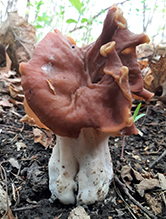 |
||
Greg Watson |
||
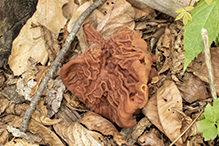 |
|
|
I found this Gyromitra brunnea growing next to a wood pile at my house in La Crescent. |
|
|
Kirk Nelson |
||
Identifying information can be found at http://www.mushroomexpert.com |
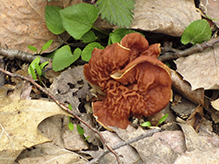 |
|
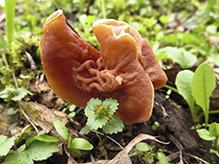 |
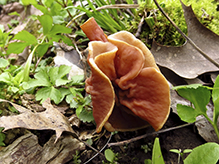 |
|
MinnesotaSeasons.com Photos |
||
|
||
|

Slideshows |
Gyromitra brunnea - fungi kingdom |
About
Published on Jan 23, 2015 Gyromitra brunnea - fungi kingdom |

Visitor Videos |
||
Share your video of this fungus. |
||
This button not working for you? |
||
|
Other Videos |
||
The Elephant Ear - Gyramitra Brunnea |
About
May 2, 2022 Finding the Elephant Ear and understanding the umbrella term "False Morel" |
Gyromitra brunnea (I believe) A.K.A. Elephant Ears |
About
May 25, 2020 Found what I believe to be Gyromitra brunnea 5/22/2020. Though these fungi are safer than the Gyromitra esculenta, I still have to parboil everything. (Many other foragers who love these fungi would scold me for it, but that's what I do.) I've been told that some Gyromitra sp. are so dangerous that you should parboil them in a vented area or be at risk from the fumes. Once metabolized the chemical in them turns into monomethylhydrazine which is a compound of rocket fuel. These are NOT a mushroom for the novice forager/mushroom hunter. Gyromitra sp. are deadly when not dealt with properly. Please proceed with extreme caution. Even if you do not want to eat these mushrooms, they are still safe to touch and are fun to find while wandering in the woods. #livefree #loveyourland #wander "Cap: 3-9 cm high; 5-10 cm wide; variable in shape but generally with 2-5 lobes raised and pinched together in a saddle-shaped formation; tan to pinkish brown or reddish brown; loosely wrinkled; lobes usually joined in seam-like lines; bald; undersurface exposed in places, whitish, downy, frequently ingrown with stem where contact occurs." References: |

Visitor Sightings |
||
Report a sighting of this fungus. |
||
This button not working for you? |
||
Blyke |
Location: Clearly Lake Cross Country Ski Trails |
 |
Greg Watson |
Location: La Crescent, MN I found this Gyromitra brunnea growing next to a wood pile at my house in La Crescent. |
 |
| Kirk Nelson 4/29/2017 |
Location: Winona County Identifying information can be found at http://www.mushroomexpert.com/gyromitra_brunnea.html. False morels are generally considered inedible and possibly toxic. |
 |
MinnesotaSeasons.com Sightings |
||
|

Created: 5/15/2017 Last Updated: © MinnesotaSeasons.com. All rights reserved. |
